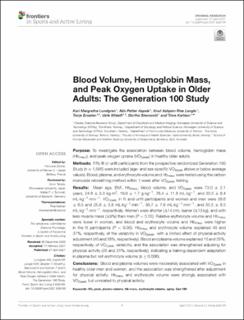| dc.description.abstract | Purpose: To investigate the association between blood volume, hemoglobin mass (Hbmass), and peak oxygen uptake (VO2peak) in healthy older adults.
Methods: Fifty fit or unfit participants from the prospective randomized Generation 100 Study (n = 1,566) were included (age- and sex-specific VO2peak above or below average values). Blood, plasma, and erythrocyte volume and Hbmass were tested using the carbon monoxide rebreathing method within 1 week after VO2peak testing.
Results: Mean age, BMI, Hbmass, blood volume, and VO2peak were 73.0 ± 2.1 years, 24.8 ± 3.3 kg·m2, 10.0 ± 1.7 g·kg−1, 76.4 ± 11.8 mL·kg−1, and 33.5 ± 8.4 mL·kg−1·min−1. VO2peak in fit and unfit participants and women and men were 38.6 ± 6.5 and 25.8 ± 3.8 mL·kg−1·min−1, 30.7 ± 7.6 mL·kg−1·min−1, and 35.5 ± 8.5 mL·kg−1·min−1, respectively. Women were shorter (Δ14 cm), leaner (Δ13 kg), and with less muscle mass (Δ9%) than men (P < 0.05). Relative erythrocyte volume and Hbmass were lower in women, and blood and erythrocyte volume and Hbmass were higher in the fit participants (P < 0.05). Hbmass and erythrocyte volume explained 40 and 37%, respectively, of the variability in VO2peak, with a limited effect of physical-activity adjustment (40 and 38%, respectively). Blood and plasma volume explained 15 and 25%, respectively, of VO2peak variability, and the association was strengthened adjusting for physical activity (25 and 31%, respectively), indicating a training-dependent adaptation in plasma but not erythrocyte volume (p ≤ 0.006).
Conclusions: Blood and plasma volumes were moderately associated with VO2peak in healthy older men and women, and the association was strengthened after adjustment for physical activity. Hbmass and erythrocyte volume were strongly associated with VO2peak but unrelated to physical activity. | en_US |

